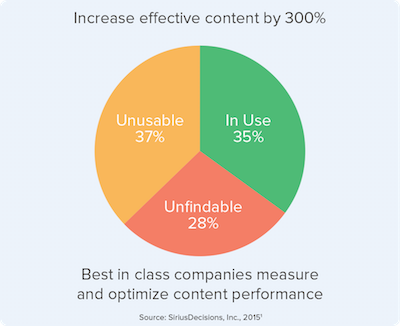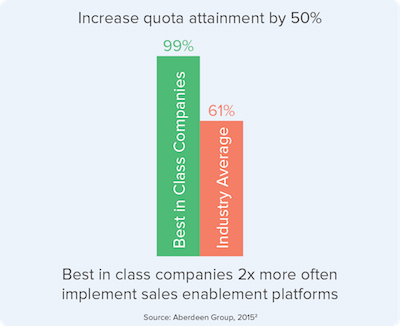The term sales enablement is sometimes used very broadly. Most organizations have teams that do "sales enablement," and many of those teams define their roles differently. In the last few years, analysts and many practitioners have coalesced around what core activities are most impactful at enabling a sales team to greater effectiveness.
This "Definitive Guide to Sales Enablement" thoroughly defines these activities, expectations for Sales Enablement technology and best practices in getting started.
If you think of the sales process as a funnel, with four basic stages, the first half is owned by marketing and is focused on generating interest in the company’s products and services. That part of the sales cycle has been transformed by the advent of marketing automation software, which allows companies to reach out to a broad audience and nurture leads until they are ready to be engaged by the sales team. The second half is primarily owned by sales, and is focused on closing deals and generating revenue. The Bottom of the Funnel (or BoFu) process is being transformed by sales enablement software that equips the sellers with the tools, skills, and assets they need to more effectively engage buyers and drive the maximum revenue for the company.
Sales enablement is a hot topic right now because companies that deploy a sales enablement solution can see dramatic ROI (return on investment) for both their marketing and sales teams.
Marketing teams know that much of the content they work so hard to produce is not yielding business results. Various studies paint a consistently grim picture. Typically, on the order of 65% of marketing content is never used by the sales team. Which means that 2/3 of the investment in this marketing content is wasted—the ROI on content that never gets used is zero.

The story gets worse. Even when content is being sent to customers, does it move the deal forward? By using tools that measure usage and performance, marketers can radically optimize their content investments, focusing on creating content that gets in front of customers and effectively drives revenue.
Ultimately, the key goal of sales enablement is to make reps more effective at closing deals and driving revenue. The opportunity is large—companies that are the best in class in their industry have 50% higher quota attainment than average companies.

And those best-in- class companies are twice as likely to be using a sales enablement solution that addresses major obstacles to driving sales:
- The time needed by a new seller to become effective (on average, 7 months)
- Seller turnover (typically 30%)
- Time wasted searching for and creating selling materials (3-4 hours per week, per rep)
The result is that sellers engage more effectively with customers, and engagement is the lifeblood of a successful sales process.
Definitive Guide Topics
This guide provides a comprehensive picture of what is needed to successfully understand, evaluate, design, launch, and operate a sales enablement platform. The guide covers the following topics:
- Chapter 1: Calculating the ROI of Sales Enablement
- Chapter 2: Evolution of Sales Enablement Solutions
- Chapter 3: Sales Enablement Platform Capabilities
- Chapter 4: Sales Enablement Maturity Model
- Chapter 5: Sales Enablement Deployment Guide
- Chapter 6: Sales Enablement Solution Design
- Chapter 7: Sales Enablement Content Performance
- Chapter 8: Sales Enablement Seller Readiness
- Chapter 9: Sales Enablement Solution Health
- Chapter 10: Conclusion
Download the “Definitive Guide to Sales Enablement” by filling out the form in the upper right of this page.
